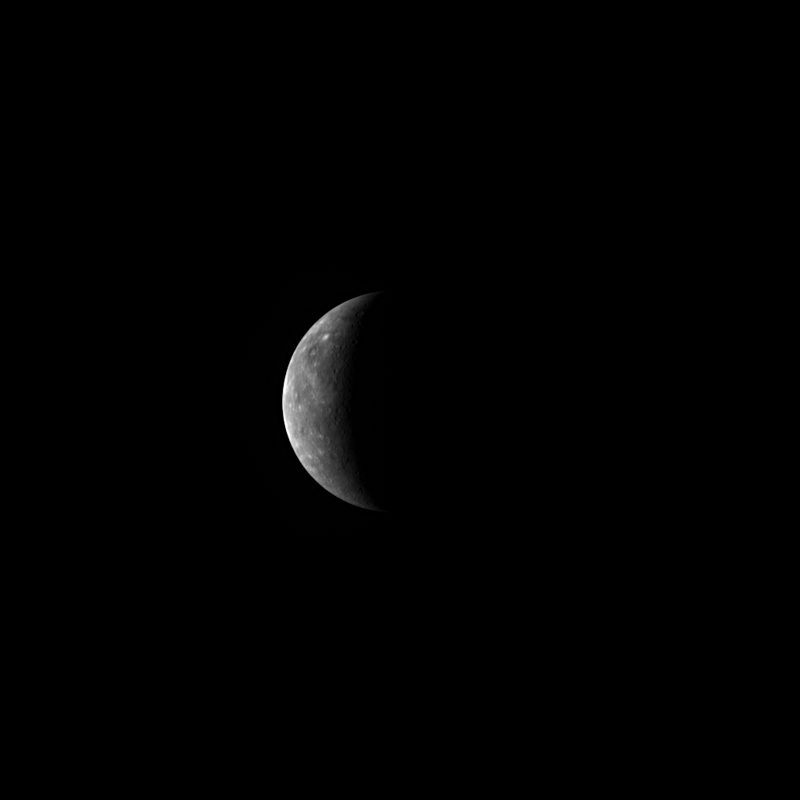NASA Probe Zooms by Mercury in Last Flyby

Thisstory was updated Sept. 29 at 7:20 p.m. EDT.
A NASAspacecraft zoomed by Mercury Tuesday to snap pictures of the planet?s unchartedregions and fine-tune its path through the solar system, one that willultimately place the probe in orbit around the small, rocky world.
TheMESSENGER probe skimmed just 142 miles (228 km) above Mercury at its closestapproach as it whipped around the planet during the flyby, the last of threedesigned to guide the spacecraft into orbit around the planet in 2011. The spacecraftwas expected to snap about 1,559 newphotographs of Mercury, some of regions never before observed up close.
?Radio signals received after the spacecraftemerged from behind the planet indicate that the spacecraft is operatingnominally,? said flight controllers at MESSENGER?smission operations center at the Johns Hopkins Applied Physics Laboratory(JHUAPL) in Laurel, Md., in a statement. ?Its instruments are now collectingimages and other scientific measurements from the planet as it departsMercury.?
The firstnew images from the flyby are expected to be released on Wednesday.
MESSENGERmade its closest approach to Mercury at about 5:55 p.m. EDT (2155 GMT) when itsped by at about 12,000 mph (19,312 kph). The probethen flew behind Mercury, passing out of communications with Earth for about anhour before restoring contact.
Mercury?sgravity was expected to slow MESSENGER by about 6,000 mph (9,656 kph) during the flyby and place it on track to enter orbitin March 2011. MESSENGER snapped a photoof the planet Sunday that revealed it as a half-lit, desolate-looking worldas seen from a distance of about 418,000 miles (672,000 km) away.
Get the Space.com Newsletter
Breaking space news, the latest updates on rocket launches, skywatching events and more!
The $446million spacecraft flew by Mercury twice in 2008 to map the planet inunprecedented detail while using the rocky world?s gravitational pull to refineits flight path through space.
?Aplanetary flyby is really like Christmas morning for scientists,? saidMESSENGER principal investigator Sean Solomon of the Carnegie Institution ofWashington before the rendezvous. ?We expect to be surprised and we expect to be delighted.?
In all,MESSENGER has photographed about 90 percent of Mercury?ssurface and was expected to cover another 5 percent of unmapped terrain when it flewby today. The spacecraft is the first probe to visit Mercury since NASA?sMariner 10 mission in the mid-1970s.
Unlike MESSENGER?s first two flybys - which revealed the firstclose-up views of Mercury in decades - Tuesday?s rendezvous was aimed atobserving specific points onthe planet?s surface. The probe was commanded to target its camera eyes at interestingcraters, measure Mercury?s magnetosphere and tenuous atmosphere, as well asstudy the planet?s odd, comet-like tail of trace gases.
?This isthe last look at Mercury?s equatorial region, and it?s the last time we flythrough the tail,? Solomon said.
WhenMESSENGER arrives in its final orbit around Mercury, it will begin along-awaited observation phase that will complete its new maps of the planet.NASA launched MESSENGER - short for MErcury Surface,Space ENvironment, GEochemistry,and Ranging - in 2004. The probe swungpast Earth once and Venus twice before beginning its three Mercury flybys.
- Video - Mercury: Messenger of the Gods
- Video - MESSENGER at Mercury
- Top 10 New Mysteries of Mercury
Join our Space Forums to keep talking space on the latest missions, night sky and more! And if you have a news tip, correction or comment, let us know at: community@space.com.

Tariq is the Editor-in-Chief of Space.com and joined the team in 2001, first as an intern and staff writer, and later as an editor. He covers human spaceflight, exploration and space science, as well as skywatching and entertainment. He became Space.com's Managing Editor in 2009 and Editor-in-Chief in 2019. Before joining Space.com, Tariq was a staff reporter for The Los Angeles Times covering education and city beats in La Habra, Fullerton and Huntington Beach. In October 2022, Tariq received the Harry Kolcum Award for excellence in space reporting from the National Space Club Florida Committee. He is also an Eagle Scout (yes, he has the Space Exploration merit badge) and went to Space Camp four times as a kid and a fifth time as an adult. He has journalism degrees from the University of Southern California and New York University. You can find Tariq at Space.com and as the co-host to the This Week In Space podcast with space historian Rod Pyle on the TWiT network. To see his latest project, you can follow Tariq on Twitter @tariqjmalik.










